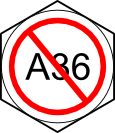
ASTM A36 is a very common steel standard that covers structural carbon steel shapes, plates and bars. Fasteners are not specifically included in the scope of A36, but that doesn’t stop engineers and contractors from asking for A36 bolts.
Why is that an issue?
The inherent problem with trying to order bolts to a ASTM steel standard, is that steel standards like A36 do not include the necessary fastener information like bolt configuration, type of or amount of threads, style of head, compatible nut or washer, acceptable coatings, etc. For example, ASTM A307, which covers low carbon general purpose bolts and studs, has the following sections detailing bolt specifics:
- Section 1.3, suitable nuts
- Section 7.1, thread geometry
- Section 7.2, head dimensions, thread length, other bolt dimensions
- Section 7.3, nut over-tapping allowances for hot dip galvanized bolts
- Section 9, test methods
- Section 13, product marking
Without these details, every mundane aspect of the fastener would need to be discussed and decided between the purchaser and the manufacturer, or assumptions would need to be made that may or may not meet the needs of the application the bolts are being used in.
ASTM A36 addresses this in the ASTM standard by including an appurtenant material chart. What this chart says is that if bolts are called out as A36, since A36 does not specifically cover bolts, then they should instead conform to the grade listed in the chart.
Below from Section 3.1 and Table 1 of A36:
When components of a steel structure are identified with this ASTM designation, but the product form is not listed in the scope of this specification, the material shall conform to one of the standards listed below unless otherwise specified by the purchaser.
| Material | ASTM Designation |
|---|---|
| Bolts | A307 Grade A |
| High Strength Bolts | A325 |
| Nuts | A563 |
| Forgings | A668 Class D |
| Anchor Bolts | F1554 Grade 36 |
| Table abridged to show only those items relevant to Portland Bolt | |
This is not to say that the materials listed above conform to or can be made from A36 steel – in many cases they cannot – simply that if the purchaser calls out a product per A36, but one that is not covered in the above scope (shapes, bars, plates), the manufacturer or supplier can supply product conforming to the above standards. For example, say someone requests A36 anchor bolts. According to this chart, those anchor bolts should be instead furnished to ASTM F1554 Grade 36. ASTM F1554 grade 36 anchor bolts are typically made from A36 or some similar low carbon raw steel, however care must be taken to make sure all the requirements of F1554 are met. Most off the floor A36 is missing the reduction of area (RA%) measurement, required by F1554, but not by A36. Additional testing may need to be performed. If, per the above chart, the anchor bolts are made per F1554, the threads, grade marking, compatible nuts, and most every other aspect and detail of the anchor bolts is already called out, saving time for both parties buy not requiring a lengthy discussion of the details, unless modifications or variances are necessary.
Portland Bolt is happy to answer questions like these or similar. We are the bolt experts; feel free to use us as a resource.
We had installed Stack of 45 meters long with A 36 Grade Anchor bolt .Did we Required bolt torquing for this stack (Dia 70 mm bolt).Kindly give the reference with standard.
@Zimkely- ASTM A36 is a raw steel standard, not a fastener or bolting standard, so there are no tension or torque requirements for it. The closest approximation that we have torque or tension values for is A307A. However, these values may not be appropriate for all applications, so be sure to confirm these with the project engineer. https://www.portlandbolt.com/technical/bolt-torque-chart/#bolt-torque-a307
Hi, i want to know if the buyer call F1554 anchor bolts, they can be made of Bars A36 and bend them and make thread, its the same? we used to do that because in my country its very hard to find F1554 anchor bolts yet, and if someone sell it, its to a very high price
@Luis- There are many similarities between A36 and F1554g36, but there are some differences as well. The chemistry, specifically the carbon content of F1554 is limited, and mechanically, F1554 requires a reduction of area measurement that A36 does not require. If you want to substitute A36 for F1554, you would need to get approval from your project engineer.
Sorry, wanted to include this in my previous comment. We get this request a number of times per year from construction people. The issue appears to be, they have Welding Procedures for A36. So if they call out A36 then they can weld structural parts to the bolts. The problem is using a low carbon (P-1 to P-1) welding procedure for any of the High Strength fasteners is a real problem. It’s okay with the F1554 36 to ASTM A36 material but when you start welding to High Strength fasteners you need to have a specific welding procedure.
Excellent article. You can see by the questions some people still don’t get it.
We are in the process of erecting some columns. They call for F1554 anchor bolts. Can a fully threaded rod of this spec be used for anchor bolts?
@Lorenzo- Yes, fully threaded rods are often used in F1554 applications. We stock all thread rod in all three F1554 grades.